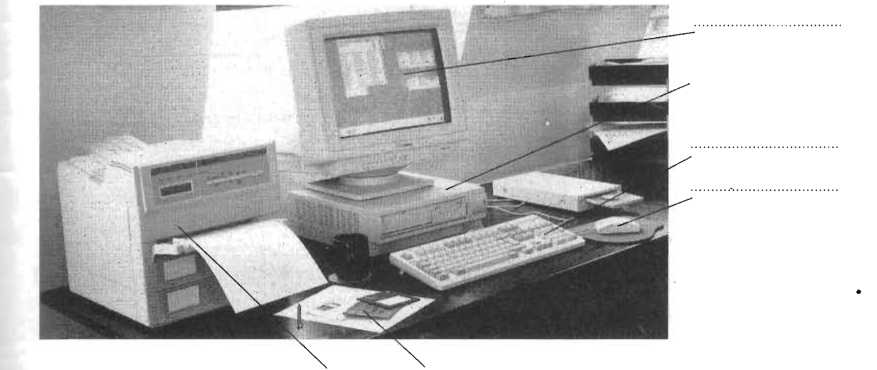
Практичне заняття №2
Тема: CONFIGURATION. What is a computer
Завдання 1. Warm-up activity
In pairs, label the elements of this computer system. Then read the text in Task 2 and check your answers.
CPU
(inside)
2
Reading
Read
the text.
What
is a computer?
Computers
are electronic machines which can accept data in a certain form,
process the data and give the results of the processing in a
specified format as information.
Three
basic steps are involved in the process: First,
data is fed into the computer’s memory. Then,
hen the program is run, the computer performs ,i set of instructions
and processes the data. Finally,
c can see the results (the output) on the screen or i:i printed form
(see Fig. 1 on p. 8).
information in the form of data and programs is known as software,
and
the electronic and mechanical parts that make up a computer system
are called hardware.
A
standard computer system consists of three main sections: the
Central
Processing
Unit (CPU), the main memory and the peripherals.
Perhaps
the most influential component is the Central
Processing Unit. Its
function is to execute program instructions and coordinate the
activities of all the other units. In a way, it is the ‘brain’
of the computer. The main
memory holds
the instructions and data which are currently being processed by the
CPU. The peripherals
are
the physical units attached to the computer. They include storage
devices and input/output devices.
Storage
devices (floppy
or hard disks) provide a permanent storage of both data and
programs. Disk
drives are
used to handle one or
more floppy disks. Input devices enable data to go into the computer’s memory. The most common input devices are the mouse and the keyboard. Output devices enable us to extract the finished product from the system. For example, the computer shows the output on the monitor or prints the results onto paper by means of a printer.
On the rear panel of the computer there are several ports into which we can plug a wide range of peripherals - modems, fax machines, optical drives and scanners.
These are the main physical units of a computer system, generally known as the configuration.
3. Use the information in the text and the diagram to help you match the terms in the box with the appropriate explanation or definition below.
software
peripheral
devices
MONITOR floppy disk HARDWARE INPUT
port
OUTPUT Central Processing Unit
The brain of the computer.
Physical parts that make up a computer system.
Programs which can be used on a particular computer system.
The information which is presented to the computer.
Results produced by a computer.
Hardware equipment attached to the CPU.
Visual display unit.
Small device used to store information. Same as ‘diskette’.
Any socket or channel in a computer system into which an input/output device v may be connected.
4.
Read and guess
Read
these slogans or quotations, and say what computer element they
refer to.
a)
‘Point and click here for power.’
b)
‘Obeys every impulse as if
it were an extension of your hand.’ __________________
a)
‘Displays your ideas with perfect brilliance.’
b)
‘See the difference - sharp images and a fantastic range of
colours.’ _______________
a)
‘I love this drive. It’s quiet and fast.’
b)
‘With this it’s easy to back up your data before it’s too
late.’ _________________
a)
‘Power and speed on the inside.’
‘Let
your computer’s brain do the work.’ __________________
a)
‘. a big impact on the production of text and graphics.’
‘Your
choice: a laser powerhouse.’ ___________________
a)
‘Your fingers will hardly know they’re working.’
b)Choose
a full 105-key layout, and type with
efficiency.’_________________________
5. Follow-up: Minis and micros
Complete the text below with the words in the box.
systems |
memory |
task |
terminals |
desktop |
CAD |
applications |
The
first microcomputers, also known as
‘ ’
PCs, were for single users
only,
and this clearly distinguished them from minicomputers. Another
important difference was that ‘minis’ were much more powerful
than ‘micros’: they could execute more than one
simultaneously and were
used
as file servers for (3) and
workstations.
However,
modern microcomputers have operating
) ...
and network facilities that
can
support many simultaneous users. Today, most personal computers have
enough
) to
be used for word processing and business (6) Some PCs
can
even handle multitasking and
(7) applications.
As a result, the
division
between ‘minis’ and ‘micros’ is now disappearing.
